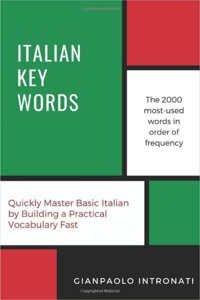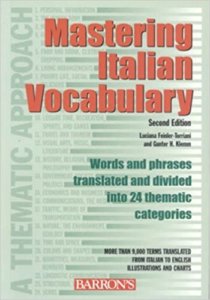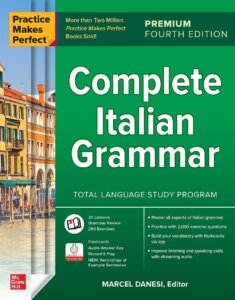Updated January 24, 2024
Wondering how to learn Italian? Maybe you’ve tried before and failed, or this is your first attempt. Regardless, this article will show you the best way to learn Italian.
So, what’s the best way to learn Italian?
Buongiorno! If you’re here, odds are you’re ready to start learning Italian or looking to pick it back up after calling it quits.
Well, you’re in luck! This article reveals how to learn Italian with 6 simple yet effective tips.
Read on to discover more about this beautiful Romance language, or jump straight to the best way to learn Italian with our 6 easy tips!
Before we start, remember that you can learn Italian or 12 other languages by downloading the Fluent Forever app and joining our Live Coaching program.
Pronti? Andiamo!
- How hard is it to learn Italian?
- How long does it take to learn Italian?
- Reasons to learn Italian
- The best way to learn Italian with 6 effective tips
- Resources to learn Italian
- A personal Italian learning story
- The Fluent Forever method: the best way to learn Italian

Learn Italian, travel to Venice! Photo by Maegan White from Pexels
How hard is it to learn Italian?
Italian is not a hard language to learn for native English speakers. According to the Foreign Service Institute (FSI), the institution responsible for preparing US diplomats, Italian is roughly as hard to pick up as other Romance languages like Spanish and Portuguese.
Italian, along with Spanish, French, and Portuguese, is a category 1 language in the FSI’s difficulty ranking system. This group is described as “languages more similar to English,” which makes them relatively easier to learn for English speakers.
Like other Romance languages, Italian stems from Latin. While not part of the same family of languages, English is also influenced by Latin. Because of this, both Italian and English share similar vocabulary and grammar. Additionally, Italian does not have a lot of new or challenging tones and sounds to learn.
All in all, Italian is one of the easiest second languages to learn for native English speakers.
That being said, there are other factors that influence how hard or easy it is to learn Italian. You can read this article where we explore the subject in detail.
How long does it take to learn Italian?
The FSI estimates that it takes a person 24 weeks or 650–700 hours to reach a “working proficiency” in Italian. This timeline is based on native English speakers and the FSI’s methodology.
In practice, there are personal and situational variables that affect how long it takes to learn the language.
For example, if a person’s native language is another Romance language instead of English, they will probably pick up Italian faster. Similarly, if they actually live in Italy and are surrounded by the language 24/7, the process will be even faster.
Check out our article here to find out how long it will take you to learn Italian.
Reasons to learn Italian
If you’re looking for the best way to learn Italian, you’re probably convinced that it’s worth picking up as a foreign language. If you need even more encouragement, here are a few top reasons why you should learn Italian.
Demographics
You will definitely find people to practice your Italian with! The European Union is home to 67 million native speakers, making it the second most widely spoken native language in the EU.
Additionally, around 13.4 million people in the Union speak it as their second language. Lastly, 85 million people speak Italian worldwide!
Culture
It’s hard to miss Italy’s international influence on art, food, movies, and history. Who doesn’t know who Da Vinci is? The Mona Lisa? Or, have you ever met someone who hasn’t tried pizza? How about lasagna?
Italy’s cultural footprint can be found all over the world, and learning Italian will allow you to appreciate these things in their original language.
Travel
With Italian living in your brain, you can visit and enjoy Italy more comfortably. Plus, the odds of you living or working there will skyrocket once you know the language.
However, Italy’s not the only place on earth where you will be able to use it. Italian is the official language of San Marino, Switzerland, the Vatican City, and some parts of Slovenia and Croatia.
Personal goals
If none of the above reasons convince you, then do it for yourself! Prove to yourself that you can learn Italian and come up with your own personal reason:
- Connect better with friends, family, and neighbors around you who speak Italian natively
- Increase your odds of working or living abroad in Italian-speaking countries
- Impress that barista from Rome who works at the corner espresso place
- Enjoy Italian movies and series more thoroughly by watching them in their original language
The best way to learn Italian is to have a solid, personal reason for starting! Got yours yet? Then let’s move on.

Blow everyone away by ordering pizza in Italian!
Photo by Kristina Paukshtite from Pexels
The best way to learn Italian with 6 effective tips
Beyond your specific native language, the methods you rely on to acquire Italian will affect how fast or slow you master it. The list below compiles tips that will show you how to learn Italian quickly and effectively.
1. Consume Italian media
The best way to learn Italian from your couch is to frequently consume Italian movies, series, podcasts, and other forms of media. Besides offering a fun and engaging method to learn the language by context, these resources show you how Italian is spoken by real people.
If you’re a beginner, you can start watching series or movies with English subtitles, so you pick up on everything being said. As you progress, try switching to Italian subtitles to strengthen your comprehension.
Here are some great Italian Netflix shows and movies you can binge-watch productively next weekend…
If you’re more interested in online media, you’ll find a host of Italian YouTubers with great content. Here’s a list of popular YouTube channels that create content for Italian enthusiasts.
Having said all of this, it’s important to point out that these resources shouldn’t be used in a vacuum. You should incorporate them as a supplement to strengthen your Italian pronunciation, vocabulary, and grammar.
2. Take an Italian course
Some people prefer to learn a language with other people rather than on their own. In these cases, the best way to learn Italian is to take a language course.
Besides making the process less lonesome, a course is usually guided by someone certified in language teaching. Additionally, the lessons provide a trustworthy source of feedback and corrections.
However, with so many offline and online options out there, how do you know which course is good for you? Here are some important things to ask yourself before signing up:
Are the teaching methods effective?
There isn’t a magic formula to learning a new language. However, there are bad, good, and better methods to go about it. For example, if the course focuses on burying your head in a grammar book or neglects speaking practice, you might want to look at other options.
On the other hand, if the course focuses on effective tools like flashcards with images and pronunciation training, you should definitely consider it.
You can learn more about how we incorporate these effective resources into our methodology.
Is it fun and engaging?
The more fun and engaging the course, the less likely you will drop your studies. Make sure that whoever guides the lessons makes each class enjoyable, interesting, and interactive.
The last thing you want to do is join a course that drains your motivation and eagerness to learn Italian.
Is the content in line with my fluency goals?
Check that the content of a course is in line with your own fluency goals or reasons for learning Italian. If the lessons focus on Italian specifically for future chefs or restaurant owners, but you’re not interested in becoming either, you might find the content boring or useless.
Talk to whoever guides the course or chat with past students to find out if the content matches what you’re looking for.
Will the course help me increase my confidence in Italian?
One of the greatest benefits of language courses is that they allow you to practice speaking in a comfortable and controlled environment. For example, an Italian course can be great if you’re planning to travel to Italy but feel apprehensive about striking up conversations with the locals.
If the study plan won’t facilitate or provide speaking practice, you might want to reconsider signing up and instead look for an option that focuses on conversation.
The Fluent Forever Live Coaching program is similar to an Italian course, with the added bonus of offering 1-on-1 tuition and answering yes to every previous question.
Our language coaches are all native speakers certified in our proven language teaching method. Furthermore, they create personalized sessions based on your interests and goals to get you speaking fast. Lastly, our coaches play the extra role of keeping you motivated to learn and holding you accountable for your progress! Why not sign up today?
3. Go to Italy!
Immersion is by far the best way to learn Italian since it entails surrounding yourself with the language as much as possible. Full immersion allows you to continuously think in your target language, build your vocabulary intuitively, and pick up on the cultural nuances involved in speaking.
Ideally, full immersion means traveling to Italy, where you’d be forced to speak, hear, and read Italian 24/7. However, not everyone can afford the luxury of dropping everything and leaving for Rome for a year.
Luckily, there are ways to somewhat mimic immersion. Here are some ideas to expose yourself to Italian in your daily life:
- Place flashcards on objects in your house with their Italian name written on them
- Follow cooking recipes in Italian
- Hang out with Italian native speakers
- Listen to Italian podcasts, music, and audiobooks
- Change the language settings on your electronics to Italian
Another somewhat cheaper alternative to traveling to Italy is to join a full immersion program. We have a list of immersion programs around the world for different languages, including Italian. You can check it out here.
4. Practice with native speakers
Practicing with native speakers is the best way to learn Italian with someone else. For starters, they can provide immediate feedback and native-level pronunciation. Additionally, they’re a constant source of new vocabulary and phrases.
This is why language learners often seek a language exchange partner to trade languages. Besides being fun to meet someone else with the same passion, it offers a great opportunity to practice speaking often.
There are different places where you can find native Italian speakers to practice. Social media is chock-full of language groups with people looking for exchange partners. There are also websites like MeetUp and MyLanguageExchange that make it easy to find in-person and online exchanges, respectively.
Remember: your safest, most effective bet of learning with a professionally trained native speaker is to join our Live Coaching program.
5. Play language learning games
A fun and engaging way to supplement your Italian is to enjoy language learning games. From board games like Scrabble, to apps where you can learn Italian vocabulary with people across the globe, there’s something out there for everyone.
We compiled a list of 11 language learning games you can check out here. There’s something in there for every level, suited for solo and team players alike.
6. Language softwares and apps
There are hundreds of language apps and other software that can help you learn Italian. Similar to consuming Italian media, these resources are a great way to supplement your learning. Additionally, they’re super practical – all you need is a working smartphone.
However, not every app is made equal. For example, apps like Duolingo that use direct translation to teach you vocabulary and grammar may hinder how long you actually remember what you learn. If you’re looking for the fastest and easiest way to learn Italian, you should steer clear of this type of app.
Instead, you should focus on apps that use flashcards and spaced repetition systems (SRS) to teach you a language.
Flashcards with images and no translation allow you to learn vocabulary and grammar faster by making you think in your target language. At the same time, SRS create review sessions based on your past performance to help you focus on the cards you have more trouble remembering.
The Fluent Forever app automates the flashcard creation process and allows you to build personalized cards with images, pictures, or drawings. Additionally, the app uses an SRS algorithm to show you the vocabulary and sentences you need to review the most!
Resources to learn Italian
To learn Italian, you’re going to need a way to learn correct pronunciation, a frequency dictionary to form your base vocabulary, and a good grammar book. You’ll also benefit from a thematic vocabulary book for specialized vocabulary and maybe a book or two once you learn your first 1,000 words.
For some reason, Italian language resources are missing a few parts. There are a lot of books that are very hard to get in the USA, and things like frequency dictionaries simply don’t seem to exist. To help make your journey easier, you can check out some of our recommended resources below (pictures are links):
Pronunciation
First off, get a feel for how pronunciation works in English. The video tutorials here should help. Once you understand that, start working on Italian. Afterwards, you can use Wikipedia’s Italian Phonology page, a free resource that can help you review Italian’s phonetics.
You can also use the DOPO (Pronunciation dictionary), recently released for free with recordings on the net. There are also some useful Anki flashcards for Italian to improve your pronunciation, such as the Italian alphabet, Italian IPA Pronunciation, Italian minimal pairs, and other useful goodies.
At a bare minimum, your goal is to easily hear and say the difference between double consonants and single consonants (caro vs carro and sete vs sette, for example), the difference between the alveolar /n/ (in cane) nasal consonant and the palatal /ɲ/ consonant (in bagno), and the difference between the palatal and alveolar lateral consonants (aglio vs allo, for example).
Once you get those, you’re pretty much ready. If you want a really perfect accent, you’ll then need to focus on getting the pure vowels just right (no American “O”s) and learning to make an unaspirated /t/, /p/, and /k/. (And if you’re a perfectionist, learn which words voice their double Zs and which unvoice them, as well as which words use closed and open Es and Os.)
Base vocabulary
We made a base vocabulary list of 625 words to start you off! As we explain in that article, we find it easiest to translate those words using the short dictionaries at the end of a Lonely Planet Phrasebook. They’re cheap, short, and they give you good, standard translations for your words (just ignore the ridiculous pronunciation guides).
Later, when you’re ready for sentences, you can go back to your phrasebook and grab some. After that, try some of these resources:
Italian Key Words is one of the only frequency lists that exist for Italian. There are a couple of online options (A 1,000-word list here and a fairly academic list of 3,100 words here), but I find that the lack of translations makes them both fairly hard to use. I’d suggest the book.
You can also access Italian vocabulary Anki decks to boost your Italian vocab, like the Italian alphabet, Italian Top 2000 Words, and many more. Il Primissimo Zanichelli dell’accoglienza is an incredible book. It describes ~1,200 words exclusively with pictures and examples that you should be able to understand on your first day. You can find example pages here.
It’s hard to get; We’ve linked to Amazon, but unless someone is selling it used or you’re buying it in Europe, it’s pretty expensive. Alternatively, you can try Book Depository, which usually will find you some better prices.
Another simpler, more straightforward option is to download and use the Fluent Forever app. The vocabulary you learn in our app is based on our frequency list, which neatly compiles the essential Italian words you need to know.
Vocabulary book
The Mastering Vocabulary series is a wonderful set of books that contain core vocab for just about any field or topic you can think of. You can certainly make do with just this book if you can’t get the Primissimo Zanichelli.
The only online Italian frequency list we’ve found is this one, which is a bit messy, but it gets the job done. If someone happens to find a better one, let us know and we’ll put it up here.
You can also find a neat set of sentences online that are ranked based on how frequently the words within those sentences show up within the language, then create Anki decks to store them with Text-to-Speech recordings of each sentence and translations. They’re a nice resource to mine for useful content.
We’d suggest finishing the 625 list, then looking through them in order for new words or new grammatical constructions, and then learning those new chunks via New Word cards, New Word Form cards, and Word Order cards.
… Or, you can make the process much, much easier and simply add the sentences directly into your Fluent Forever app. Our custom flashcard creator makes this process as easy as 1, 2, 3!
Grammar book
Complete Italian Grammar is a fantastic resource for conjugations, tenses, and overall grammar rules. Make sure the version you get includes the exercise workbook!
We’re big fans of the Tuffo/Volo nell’Azzurro series, but they’re hard to find in the US (they’re also 100% in Italian, which is not everyone’s cup of tea). You can often find affordable copies on Book Depository (or try Amazon if you’re not in the US).
In terms of something a bit easier to get a hold of, the Practice Makes Perfect series is well reviewed and covers the whole body of Italian grammar at a sufficiently high level. The only problem with this book seems to be with vocabulary, which you’re dealing with already in step 2.
Book-type book
You can read anything that you enjoy. I’m a big fan of the Harry Potter series in translation. You can find an audiobook version to listen to at the same time as reading.
Anki decks
You might already know Gabe Wyner. He’s the co-author of this article, a bonafide polyglot, and the CEO and founder of Fluent Forever. Well, here’s his personal Anki deck available here. Please read the notes!
If you have more questions about Anki and learning Italian, there’s also the Anki language learners community on Reddit. You can even check out this Anki language learning blog.
Remember, the Fluent Forever app is a faster flashcard app. It automates the process of creating image cards and personalized review sessions.
Monolingual dictionaries
You’ll want to move to a monolingual dictionary as soon as possible. For example, We’re big fans of Hoepli’s online dictionary. For starters, Hoepli’s tends to be easy to understand. You might need to make an account, but then it’s free.
Assimil
The Assimil series is a sort of special language learning resource that we discuss in a blog post here. It doesn’t quite fit into any of the categories above, and we think it works best as a sort of supplemental source of Italian input.
Dictionarist
Dictionarist provides translations, example sentences, conjugations, and synonyms for a number of languages including Italian.
The best way to learn Italian on your own – a personal story
Learning a new language, be it Italian or another language, can be intimidating, especially if you’re doing it on your own. Some people try, fail, and somehow convince themselves that they’re not made to learn a language.
That’s not the case.
Believe it or not, our founder and CEO Gabe struggled to learn languages in high school. It wasn’t until he learned German that he realized that anyone can learn a new language – it’s just a matter of having the right tools and using the proper methods.
From that point on, he embarked on a mission to learn other languages. His journey led him to discover 3 tools that helped him learn French, Russian, and Japanese in record time:
- Learn pronunciation first
- Don’t use translations
- Practice with flashcards
Finally, convinced about his finding, he wrote a bestselling book about his story. Later, realizing that no one had brought these language learning resources together, he developed the Fluent Forever method.
The Fluent Forever method: the best way to learn Italian
Together, the Fluent Forever app and Live Coaching program provide you with our proven and effective 4-Step Method to master Italian:
Step 1 – The app prepares your ears to pick up Italian sounds with pronunciation tests.
Step 2 – Through the awesome power of flashcards, you learn essential Italian vocabulary. Using our patented SRS algorithm, the app automates the process of creating flashcards with images and reviewing them effectively.
Step 3 – Later, and using relevant phrases and the words you’ve already learned, the app will teach you grammar with flashcards. Additionally, you can choose which sentences you want to practice with or add some of your own!
Step 4 – To tie everything up, our language coaches will help build your Italian speaking skills. Our coaches are 100% native speakers and certified in our teaching method. Also, your 1-on-1 sessions are based on your fluency goals and personal interests, creating engaging and relevant lessons for you.
So, are you ready to learn Italian? Download the Fluent Forever app, join the Live Coaching program, and reach fluency fast!
Disclaimer: As an Amazon Associate, Fluent Forever earns from qualifying purchases.
[shareaholic app="share_buttons" id="28313910"]






















